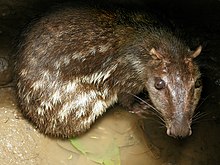Lowland paca
| Lowland paca[1] | |
|---|---|

| |
| Scientific classification | |
| Domain: | Eukaryota |
| Kingdom: | Animalia |
| Phylum: | Chordata |
| Class: | Mammalia |
| Order: | Rodentia |
| Family: | Cuniculidae |
| Genus: | Cuniculus |
| Species: | C. paca
|
| Binomial name | |
| Cuniculus paca | |

| |
| Lowland paca range[2] | |
| Synonyms | |
|
Mus paca Linnaeus, 1766 | |
The lowland paca (Cuniculus paca), also known as the spotted paca, is a large rodent found in
The animal is called paca in most of its range, but tepezcuintle (original Aztec language name) in most of
There is much confusion in the nomenclature of this and related species; see
Etymology
The word paca comes from a word in the Tupi language that designates the animal but also means 'awaken, alert'.[7][8] Tepezcuintle is of Nahuatl origin, meaning 'mountain-dog', from tepetl, 'mountain' + itzquintli, 'dog'.
Description


The lowland paca has coarse fur without underfur, dark brown to black on the upper body and white or yellowish on the underbelly. It usually has three to five rows of white spots along its sides, against a dark grey background. It has thick strong legs, with four digits in the forefeet and five in the hind feet (the first and fifth are reduced); the nails function as hooves. The tail is short and hairless. The zygomatic arch is expanded laterally and dorsally and is used as a resonating chamber - a unique feature among mammals.
An adult lowland paca weighs between 6 and 12 kilograms (13 and 26 lb). Each litter has one young lowland paca, sometimes two. They usually have one to three young a year with a gestation period of about 115–120 days. Pacas are sexually mature at about 1 year. A paca usually lives up to 13 years.
The lowland paca can carry leishmaniasis and trypanosomiasis.[9]
Habits

The lowland paca is mostly nocturnal and solitary and does not vocalize very much. It lives in forested habitats near water, preferably smaller rivers, and dig simple burrows about 2 m (6 ft 7 in) below the surface, usually with more than one exit. It can also sometimes live in burrows created by other animals. The lowland paca is a good swimmer and usually heads for the water to escape danger, as it can stay under water for several minutes. It also is a very good climber and it searches for fruit in the trees.
The lowland paca can be considered an important seed distributor, since its diet includes leaves, stems, roots, tubers, nuts,
Economical and ecological aspects
The lowland paca is considered an agricultural pest for
See also
References
- OCLC 62265494.
- ^ . Retrieved 19 November 2021.
- ISBN 9780643099166
- ISBN 9789251036402.
- ^ (in Spanish) Fauna y flora de la cuenca media del Río Lebrija en Rionegro, Santander - Humboldt Institute
- OCLC 62265494.
- ^ "Curso de Tupi Antigo". Archived from the original on 2012-08-09. Retrieved 2012-09-10.
- ^ Ferreira, A. B. H.; Novo Dicionário da Língua Portuguesa; 2nd ed.; Rio de Janeiro: Nova Fronteira; 1986; pp. 1, 243
- ^ a b c "The Online Guide to the Animals of Trinidad and Tobago" (PDF). The University of the West Indies at St Augustine.
- ^ "Cuniculus paca (Lowland paca)". Animal Diversity Web.
- S2CID 258012401.
- ISBN 9789251036402.
External links
- ITIS database
- Animal Diversity Web
- (in Spanish) Convenio Andrés Bello, archived
- Zoochat image

